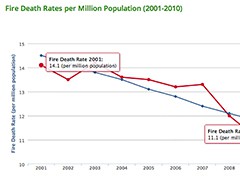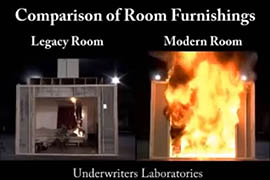Cronkite News has moved to a new home at cronkitenews.azpbs.org. Use this site to search archives from 2011 to May 2015. You can search the new site for current stories.
Prevention, education helped Arizona to nation’s lowest fire-death risk
WASHINGTON – Arizona had the nation’s lowest risk of fire death in 2010, a fact experts attributed to everything from a relatively low number of high-rises to building codes in some localities that require residential sprinklers.
The U.S. Fire Administration said the fire-death rate for Arizona was 5.5 per million residents in 2010, the last year for which official statistics are available.
Arizona joined two other states – Oregon and Massachusetts – where the likelihood of death in a structure fire was half the national rate of 11.1 deaths per million.
There had been at least 26 civilian fire deaths reported in Arizona as of Thursday, according to media reports tracked by USFA, putting the state roughly on track with last year.
While fire death rates in Arizona and nationwide have been declining for decades, experts said the numbers are still too high for what should be preventable losses.
“Fire in the United States still is a very big problem,” said U.S. Fire Administrator Ernest Mitchell Jr.
“We still need to have a sense of urgency” about preventing fires, said Mitchell, whose agency was established in 1974 to educate the public on fire safety and combat public indifference to fire prevention.
His comments came at the kickoff Monday of “Fire is Everyone’s Fight.” The awareness campaign aims to “change the way people think” about fires – from looking at them as accidents, to seeing them as things they can prevent or protect against, Mitchell said.
Simple steps such as testing smoke alarms and taking precautions while cooking could prevent many household fires, which he said make up more than 80 percent of fire deaths and 76 percent of fire injuries.
Additional measures, such as home sprinkler systems, are becoming more affordable, he said, with insurance companies providing discounts of 13 to 30 percent on premiums for homeowners who install them.
Sprinklers were cited as one of the factors responsible for low fire fatality rates in Arizona, said State Fire Marshal Bob Barger. He pointed to building codes in Scottsdale, Fountain Hills and Paradise Valley that have “zero tolerance” for new construction without them.
But the best mechanism is prevention, he said, a lot of which comes through educating children about fire safety in school so they take the message home to their parents.
“It’s a combination of things,” Barger said. “Awareness is the biggest – education and prevention.”
The Phoenix Fire Department does more than 500 education and awareness events a year, said Capt. Jonathan Jacobs, and requests for such events have been increasing.
“When they call, we get someone there,” he said.
Jacobs said one of the most important messages is to remind people to have working smoke detectors in places like their kitchens and the hallways outside bedrooms.
“That right there is the single thing that’s going to save someone’s life,” Jacobs said. “Most people don’t die from fire, they die from smoke inhalation, carbon dioxide poisoning … they’re incapacitated in some fashion by the smoke.”
Smoke detector batteries should be replaced at least once a year and the detectors themselves should be replaced every eight to 10 years, experts say. Newer smoke alarms can detect smoke from both slow-moving smoldering fires and fast-moving flash fires, Jacobs said, which is critical when every second counts.
Barger said a fire doubles in size every 30 seconds, which is why it is “even more important to have early warning.”
“Almost every time we have a fatality, it’s because the fire alarm has been taken apart or the batteries removed,” Barger said.
Pam Elliott, a nurse and fire prevention advocate, suffered third-degree burns over 50 percent of her body in a fire in her West Virginia home when she was 5.
She joined Mitchell on Monday to urge homeowners and homebuilders to install fire sprinklers, which she said not only help give children and the elderly more time to get out, but also reduce property damage from fires.
“Combining smoke alarms, a practiced fire escape plan, and installing home fire sprinklers, we can reduce fire death by 82 percent and fire damage by 97 percent,” Elliott said. She added that it has been more than 50 years “since my injury and we need a lot more prevention.”










